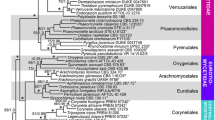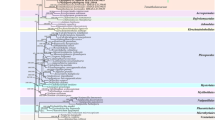Abstract
More than twenty species of lichenicolous fungi have been described in Phoma, a large anamorphic genus of primarily plant-associated pathogens with broad geographic distributions. We obtained nuclear and mitochondrial rDNA sequences from 19 fungal cultures isolated from specimens representing four described and two undescribed lichenicolous species in the genus. Our multilocus phylogeny indicates that lichenicolous Phoma species represent at least two phylogenetically distinct clades in the Phaeosphaeriaceae, one including a new species, Phoma puncteliae, isolated from a specimen of Punctelia rudecta collected in Maryland, USA, and another group of primarily lichenicolous species. This latter group includes four described lichenicolous Phoma species, an unidentified melanized rock fungus, and a new lichenicolous Phoma species isolated from Xanthomendoza species collected in Canada that we are naming P. xanthomendozae. Some specimens in this clade collected from different lichen genera and species were found to be very similar genetically, which calls into question the recent practice of recognizing lichenicolous Phoma species mainly by differences in host preference.






Similar content being viewed by others
References
Alstrup V, Kocourková J, Kukwa M, Motiejūnaitė J, Brackel W von, Suija A (2009) The lichens and lichenicolous fungi of South Greenland. Folia Cryptogamica Estonica 46:1–24
Arnold AE, Miadlikowska J, Higgins KL, Sarvate SD, Gugger P, Way A, Hofstetter V, Kauff F, Lutzoni F (2009) A phylogenetic estimation of trophic transition networks for ascomycetous fungi: are lichens cradles of symbiotrophic diversification? Systematic Biology 58:283–297
Aveskamp MM, de Gruyter J, Crous PW (2008) Biology and recent developments in the systematics of Phoma, a complex genus of major quarantine significance. Fungal Diversity 31:1–18
Aveskamp MM, de Gruyter J, Woudenberg JHC, Verkley GJM, Crous PW (2010) Highlights of the Didymellaceae: a polyphasic approach to characterise Phoma and related pleosporalean genera. Stud Mycol 65:1–60
Berger F, Türk R (1993) Neue und seltene Flechten und lichenicole Pilze aus Oberösterreich, Österreich. Linzer Biologische Beitrage 25:167–204
Boerema GH (1997) Contributions toward a monograph of Phoma (coelomycetes) V. Subdivision of the genus in sections. Mycotaxon 64:321–333
Boerema GH, de Gruyter J, Noordeloos ME, Hamers MEC (2004) Phoma identification manual. Differentiation of specific and infra-specific taxa in culture. CABI Publishing, Wallingford, p 470
Brackel W von (2008a) Phoma ficuzzae sp. nov. and some other lichenicolous fungi from Sicily, Italy. Sauteria 15:103–120
Brackel W von (2008b) Zwackhiomyces echinulatus sp. nov. and some other lichenicolous fungi from Sicily, Italy. Herzogia 21:181–198
Brackel W von (2010) Weitere Funde von flechtenbewohnenden Pilzen in Bayern. Beiträge zu einer Checkliste V. Berichte der Bayerischen Botanischen Gesellschaft 80:5–32
Câmara MPS, Palm ME, van Berkum P, O’Neill RN (2002) Molecular phylogeny of Leptosphaeria and Phaeosphaeria. Mycologia 94:630–640
Crous PW, Wood AR, Okada G, Groenwald JZ (2008) Foliicolous microfungi occurring on Encephalartos. Persoonia 21:135–146
Crous PW, Braun U, Wingfield MJ, Wood AR, Shin HD, Summerell BA, Alfenas AC, Cumagun CJR, Groenewald JZ (2009) Phylogeny and taxonomy of obscure genera of microfungi. Persoonia 22:139–161
de Gruyter J, Aveskamp MM, Woudenberg JHC, Verkley GJM, Groenewald JZ, Crous PW (2009) Molecular phylogeny of Phoma and allied anamorph genera: toward a reclassification of the Phoma complex. Mycol Res 113:508–519
de Gruyter J, Woudenberg JHC, Aveskamp MM, Verkley GJM, Groenewald JZ, Crous PW (2010) Systematic reappraisal of species in Phoma section Paraphoma, Pyrenochaeta and Pleurophoma. Mycologia 102:1066–1081
Diederich P, Kocourková J, Etayo J, Zhurbenko M (2007) The lichenicolous Phoma species (coelomycetes) on Cladonia. Lichenologist 39:153–163
Diederich P, Lawrey JD, Sikaroodi M, van den Boom PG, Ertz D (2012) Briancoppinsia, a new coelomycetous genus of Arthoniaceae (Arthoniales) for the lichenicolous Phoma cytospora with a key to this and similar taxa. Fungal Diversity 52:1–12
Edgar RC (2004) MUSCLE: multiple sequence alignment with high accuracy and high throughput. Nucleic Acids Res 32:1792–1797
Etayo J, Diederich P (1995) Lichenicolous fungi from the western Pyrenees, France and Spain. I. New species of deuteromycetes. In: Daniëls FJA, Schulz M, Peine J (eds) Flechten Follmann. Contributions to lichenology in Honour of Gerhard Follmann. Geobotanical and Phytotaxonomical Study Group, Botanical Institute, University of Cologne, Cologne, pp. 205–221
Felsenstein J (1985) Confidence limits on phylogenies: an approach using the bootstrap. Evolution 39:783–791
Gueidan C, Ruibal CV, de Hoog GS, Gorbushina AA, Untereiner WA, Lutzoni F (2008) A rock-inhabiting ancestor for mutualistic and pathogen-rich fungal lineages. Stud Mycol 61:111–119
Guindon S, Gascuel O (2003) A simple, fast, and accurate algorithm to estimate large phylogenies by maximum likelihood. Syst Biol 52:696–704
Hafellner J (2000) Zur Biodiversität lichenisierter und lichenicoler Pilze in den Eisenerzer Alpen (Steiermark). Mitt. naturwiss. Ver. Steiermark 130:71–106
Hafellner J, Kocourková J, Obermayer W (2004) Records of lichenicolous fungi from the northern Schladminger Tauern (Eastern Alps, Austria, Styria). Herzogia 17:59–66
Hafellner J, Obermayer S, Obermayer W (2005) Zur Diversität der Flechten und lichenicolen Pilze im Hochschwab-Massiv (Nordalpen, Steiermark). Mitt. naturwiss. Ver. Steiermark 134:57–103
Hafellner J, Herzog G, Mayrhofer H (2008) Zur Diversität von lichenisierten und lichenicolen Pilzen in den Ennstaler Alpen (Österreich: Steiermark, Oberösterreich). Mitt. naturwiss. Ver. Steiermark 137:131–204
Harutyunyan S, Muggia L, Grube M (2008) Black fungi in lichens from seasonally arid habitats. Stud Mycol 61:83–90
Hawksworth DL (1981) The lichenicolous coelomycetes. Bulletin of the British Museum (Natural History). Botany Series 9:1–98
Hawksworth DL (2001) The magnitude of fungal diversity: the 1.5 million species estimate revisited. Mycol Res 105:1422–1432
Hawksworth DL, Cole MS (2004) Phoma fuliginosa sp. nov., from Caloplaca trachyphylla in Nebraska, with a key to the known lichenicolous species. Lichenologist 36:7–13
Hawksworth DL, Rossman AY (1997) Where are all the undescribed fungi? Phytopathology 87:888–891
Higgins KL, Arnold AE, Miadlikowska J et al (2007) Phylogenetic relationships, host affinity, and geographic structure of boreal and arctic endophytes from three major plant lineages. Mol Phylogenet Evol 42:543–555
Hofstetter V, Miadlikowska J, Kauff F, Lutzoni F (2007) Phylogenetic comparison of protein-coding versus ribosomal RNA-coding sequence data: a case study of the Lecanoromycetes (Ascomycota). Mol Phylogenet Evol 44:412–426
Huang Y, Niu B, Gao Y, Fu L, Li W (2010) CD-HIT Suite: a web server for clustering and comparing biological sequences. Bioinformatics 26:680–682
Huelsenbeck JP, Ronquist F (2001) MRBAYES: Bayesian inference of phylogenetic trees. Bioinformatics 17:754–755
Katoh K, Misawa K, Kuma K-I, Miyata T (2002) MAFFT: a novel method for rapid multiple sequence alignment based on fast Fourier transform. Nucleic Acids Res 30:3059–3066
Katoh K, Toh H (2010) Parallelization of the MAAFT multiple sequence alignment program. Bioinformatics 26:1899–1900
Kauff F, Lutzoni F (2002) Phylogeny of the Gyalectales and Ostropales (Ascomycota: Fungi): among and within order relationships based on nuclear ribosomal RNA small and large subunits. Mol Phylogenet Evol 25:138–156
Kauff F, Lutzoni F (2003) Compat.py—a program to detect topological conflict between supported clades in phylogenetic trees, available online at http://www.lutzonilab.net/pages/download.shtml
Khodosovtsev AY, Umanets OY (2009) Phoma cladoniicola Diederich, Kocourk. & Etayo, a new for Ukraine lichenicolous fungus from Oleshkivs’ky Sands. Chornomors’k. bot. z., 5:273–275
Kondratyuk S, Kärnefelt I, Goward T, Galloway D, Kudratov I, Lackovičova A, Lisická E, Guttová A (2010) Diagnoses of new taxa. In Oksner AM: Flora lišajnikiv Ukraini y dvoch tomach, Tom 2, Vypusk 3. Kiiv, Naukovo Dumka: 435–445
Larget B, Simon DL (1999) Markov chain Monte Carlo algorithms for the Bayesian analysis of phylogenetic trees. Mol Biol Evol 16:750–759
Lawrey JD (2002) Isolation and culture of lichenicolous fungi. In: Kranner I, Beckett R, Varma A (eds) Protocols in lichenology: culturing, biochemistry, physiology and use in biomonitoring. Springer, Berlin, pp 75–84
Lawrey JD, Diederich P (2003) Lichenicolous fungi: interactions, evolution, and biodiversity. Bryologist 106:80–120
Lawrey JD, Diederich P, Nelsen MP, Sikaroodi M, Gillevet PM, Brand AM, van den Boom P (2011) The obligately lichenicolous genus Lichenoconium represents a novel lineage in the Dothideomycetes. Fungal Biology 115:176–187
Maddison WP, Maddison DR (2010) Mesquite: a modular system for evolutionary analysis. Version 2.73 http://mesquiteproject.org
Miller MA, Pfeiffer W, Schwartz T (2010) Creating the CIPRES Science Gateway for inference of large phylogenetic trees. Proceedings of the Gateway Computing Environments Workshop (GCE), 14 Nov. 2010, New Orleans, USA, pp. 1–8
Motiejūnaitė J, Brackel W von, Stončius D, Preikša Ž (2011) Contribution to the Lithuanian flora of lichens and allied fungi. III. Botanica Lithuanica 17:39–46
Nelsen MP, Lücking R, Grube M, Mbatchou JS, Muggia L, Rivas Plata E, Lumbsch HT (2009) Unravelling the phylogenetic relationships of lichenised fungi in Dothideomyceta. Stud Mycol 64:135–144
Nylander JA, Wilgenbusch JC, Warren DL, Swofford DL (2008) AWTY (are we there yet?): a system for graphical exploration of MCMC convergence in Bayesian phylogenetics. Bioinformatics 24:581–583
Posada D (2008) jModelTest: phylogenetic model averaging. Mol Biol Evol 25:1253–1256
Ruibal C, Platas G, Bills GF (2008) High diversity and morphological convergence among melanised fungi from rock formations in the Central Mountain System of Spain. Persoonia 21:93–110
Ruibal C, Gueidan C, Selbmann L, Gorbushina AA, Crous PW, Groenewald JZ, Muggia L, Grube M, Isola D, Schoch CL, Staley JT, Lutzoni F, de Hoog GS (2009) Phylogeny of rock-inhabiting fungi related to Dothideomycetes. Stud Mycol 64:123–133
Smith SA, Dunn CW (2008) Phyutility: a phyloinformatics tool for trees, alignments and molecular data. Bioinformatics 24:715–716
Stamatakis A (2006) RAxML-VI-HPC: maximum likelihood-based phylogenetic analyses with thousands of taxa and mixed models. Bioinformatics 22:2688–2690
Sutton BC (1980) The coelomycetes: Fungi imperfecti with pycnidia, acervuli and stromata. CMI, Kew, p 696
Urbanavichus G, Urbanavichene I (2011) New records of lichens and lichenicolous fungi from the Ural Mountains, Russia. Folia Cryptogamica Estonica 48:119–124
Wilgenbusch JC, Warren DL, Swofford DL (2004) AWTY: a system for graphical exploration of MCMC convergence in Bayesian phylogenetic inference. http://ceb.csit.fsu.edu/awty
Zhang Y, Schoch CL, Fournier J, Crous PW, de Gruyter J, Woudenberg JHC, Hirayama K, Tanaka K, Pointing SB, Spatafora JW, Hyde KD (2009) Multi-locus phylogeny of Pleosporales: a taxonomic, ecological and evolutionary re-evaluation. Stud Mycol 64:85–102
Zhang Y, Crous PW, Schoch CL, Hyde KD (2012) Pleosporales. Fungal Diversity 53:1–221
Zhurbenko MP (2009) Lichenicolous fungi and some lichens from the Holarctic. Opuscula Philolichenum 6:87–120
Zoller S, Scheidegger C, Sperisen C (1999) PCR primers for the amplification of mitochondrial small subunit ribosomal DNA of lichen-forming ascomycetes. Lichenologist 31:511–516
Acknowledgements
We thank Peter Scholz for providing us with a copy of the original description of Phoma pisutii, and Walter Obermayer for searching for an isotype of P. pisutii. Sequencing partially supported by grant DEB 0841405 from the National Science Foundation. MPN is supported by the Brown Family Graduate Fellowship through the Field Museum.
Author information
Authors and Affiliations
Corresponding author
Electronic supplementary materials
Below is the link to the electronic supplementary material.
Table S1
Specimens and sequences used in two-locus (nuLSU + mtSSU) phylogenetic analysis of lichenicolous Phoma species and relatives in the Pleosporales (Fig. 1). (XLSX 16 kb)
Rights and permissions
About this article
Cite this article
Lawrey, J.D., Diederich, P., Nelsen, M.P. et al. Phylogenetic placement of lichenicolous Phoma species in the Phaeosphaeriaceae (Pleosporales, Dothideomycetes). Fungal Diversity 55, 195–213 (2012). https://doi.org/10.1007/s13225-012-0166-9
Received:
Accepted:
Published:
Issue Date:
DOI: https://doi.org/10.1007/s13225-012-0166-9




